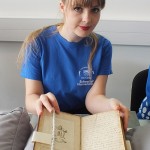 I am a final year history student with a fondness for Episcopalian endowed libraries. My dissertation focuses on the library and reader responses of Alexander Jolly, an Episcopalian Bishop. He collected over 3,000 books in his lifetime, many of which he annotated. I hope to pursue an M.Litt in Book History after graduation, and learn more about material bibliography in addition to reader responses to texts.
I am a final year history student with a fondness for Episcopalian endowed libraries. My dissertation focuses on the library and reader responses of Alexander Jolly, an Episcopalian Bishop. He collected over 3,000 books in his lifetime, many of which he annotated. I hope to pursue an M.Litt in Book History after graduation, and learn more about material bibliography in addition to reader responses to texts.
William Robertson. The history of Scotland during the reigns of Queen Mary and King James VI, till his accession to the crown of England. With a review of the Scottish history previous to that period; and an appendix containing original papers (4th ed. London: Printed for A. Millar, 1761. v1)
Brechin Collection Br U 941.05.R 652
This copy of Robertson’s History belonged to William Abernethy Drummond. Abernethy Drummond was born in 1720, and served as Bishop of Brechin in 1787. He was passionately nonjuring for the majority of his ecclesiastical career, until the death of Charles Edward Stuart in 1788. The book would have been available to clergy and lay members in the Diocese library, which he had left his library to. Abernethy Drummond introduces the book with a warning, writing on the inside page that “whoever reads this history ought in justice to that most amiable and much injured Princess Queen Mary read Mr Tytler’s historical and critical enquiry, whereby he will perceive how grossly she has been abused by both Dr Robertson and Mr Hume.” He goes on to express what he considers the only fault with Tytler; his condemnation “without sufficient proof” of the Earl of Boswell as guilty of Darnley’s murder, and his failure to vindicate the marriage of Mary to Boswell. Abernethy Drummond’s inscription is valuable as a Nonjuring response to Robertson and Hume’s unionist narratives. His recommendation of Tytler reflects a preference among Episcopalians for a history more sympathetic to the Stuarts. Tytler is also recommended by Bishop Jolly (1756-1838) in his copy of Robertson’s History held in the NLS. Both serve as a valuable insight into the Episcopalian relationship with Scottish identity and past.

Comments are closed.